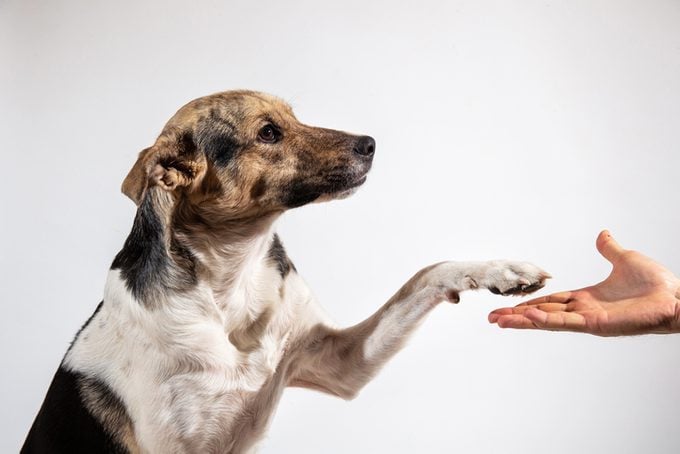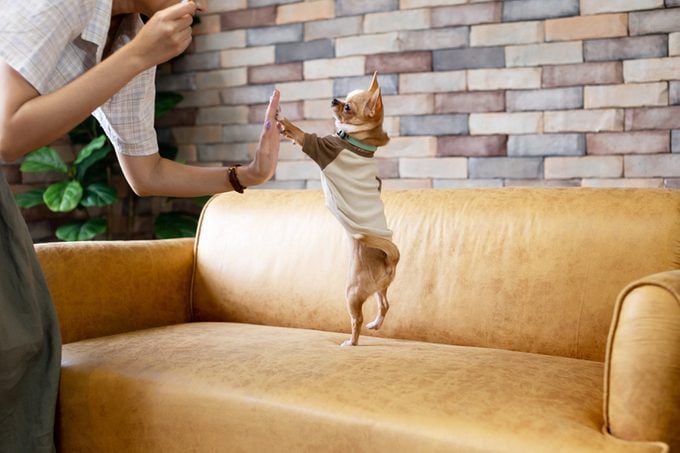You Can Find Out If Your Dog Is Right- or Left-Handed—Here’s How
Updated: Feb. 17, 2023

According to a 2021 large-scale study, 74 percent of dogs have a preferred paw
Our favorite fluffy companions are always expressing their wants and preferences. Whether that’s the kibble they scarf down, the dog toy they take to bed at night, or even the neighborhood dog they just have to say hi to, dogs build their routines around all their favorite things and people.
But did you know that dogs, like humans, often have a preferred paw as well? Maybe you’ve noticed Fido prefers to shake with his right paw, like 90 percent of humans in the Western hemisphere. Or maybe Lassie is a leftie when she paws at your leg for pets.
Well, good news: you’re not imagining things. A 2021 English study of 17,901 dogs (of unknown neuter status) confirms that the majority of them favor one paw over the other. Here’s what we know.
Are dogs right- or left-handed?
Interestingly enough, researchers discovered that on the “population level,” dogs seem to slightly favor their right paw over their left in a similar, but much less extreme, way as humans favor their right hands. In the study, 60.7 percent of female dogs and 56.1 percent of male dogs preferred using the front right paw when retrieving food from a tube in trials.
However, it’s also possible that dogs prefer using different paws to complete different tasks. In one small study on dogs’ motor bias, published in 2018, “[f]indings suggest that paw preference in the dog is not consistent between tasks, although stable over time.” For example, in monitoring the behaviors of 32 dogs, researchers Deborah L. Wells, Peter G. Hepper, Adam D.S. Milligan, and Shanis Barnard noticed that “dogs were significantly more inclined towards ambilaterality” (using either paw) on tests when they took steps as opposed to tests where they reached for a Kong ball.
Naturally, this is a far smaller (and older) study, but it still gestures towards an interesting question on dogs’ motor biases.
Factors in paw preference

There is much left to be discovered still on paw preference, but it is currently understood that a dog’s paw preference correlates to asymmetries between the left and right hemispheres of the brain. Much like humans, left-pawed dogs may be right-hemisphere dominant and right-pawed dogs may rely more on the left hemisphere. This concept is referred to as “laterality.”
The 2021 study seems to suggest that sex (and by extension, sex hormones) may play a key role in determining laterality in dogs. Additionally, the researchers found that older dogs tended towards a right-paw preference when compared to younger dogs, suggesting that age may be a factor as well.
Meanings behind paw preference
The significance of paw preference is hotly debated. The 2018 study cited above claims that “left-limbed animals …show stronger fear responses than right-limbed animals,” and that “motor asymmetry has the potential to be used as a predictor of welfare risk.”
However, much like claims that left-handed humans are more creative than right-handers, many detractors are suspicious of confirmation bias. In a separate paper, Deborah Wells herself claims that “the question still remains as to whether or not paw preference testing can, or should, be used as a measure of animal welfare.” Both her and the team behind a critical review of the 2018 study state that much more research needs to be done before making any stark conclusions on what paw preference can indicate about a dog’s personality or emotional needs.
How to determine your dog’s paw preference

If you’re curious about your own dog’s paw preferences, the easiest method to determine them is to ask your dog to sit and give you a paw. However, if you want to be technical—and why not?—try giving the dog a treat toy and seeing which paw they bat at it with, or ask them to descend some stairs and see which paw they step with first. Whether or not your results are conclusive, it’s a cute way to spend more time with your best friend, and that’s always worthwhile!
Sources:
- Science Direct: “The effect of sex and age on paw use within a large sample of dogs (Canis familiaris)”
- Science Direct: “Stability of motor bias in the domestic dog, Canis familiaris“
Science Direct: “Paw preference as a tool for assessing emotional functioning and welfare in dogs and cats: A review“ - Science Direct: “Testing of behavioural asymmetries as markers for brain lateralization of emotional states in pet dogs: A critical review“


















